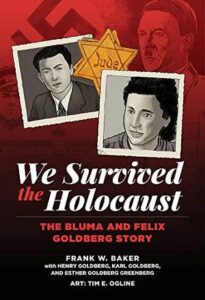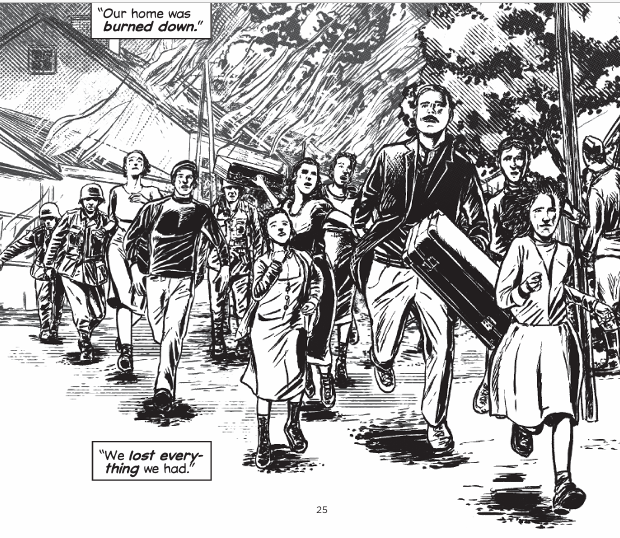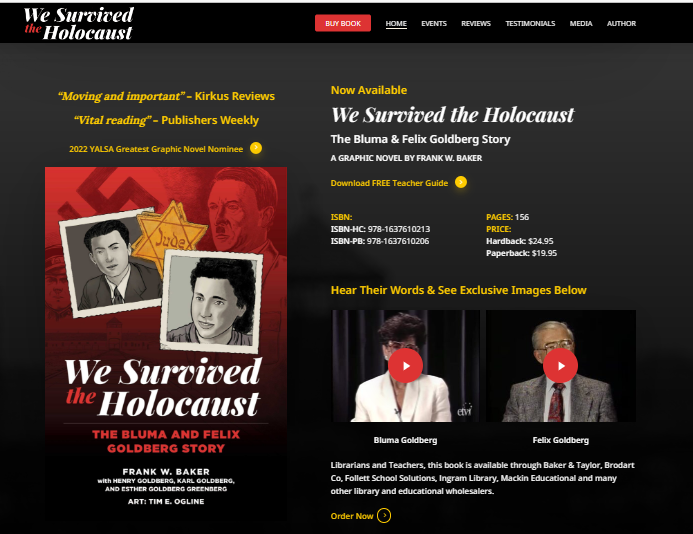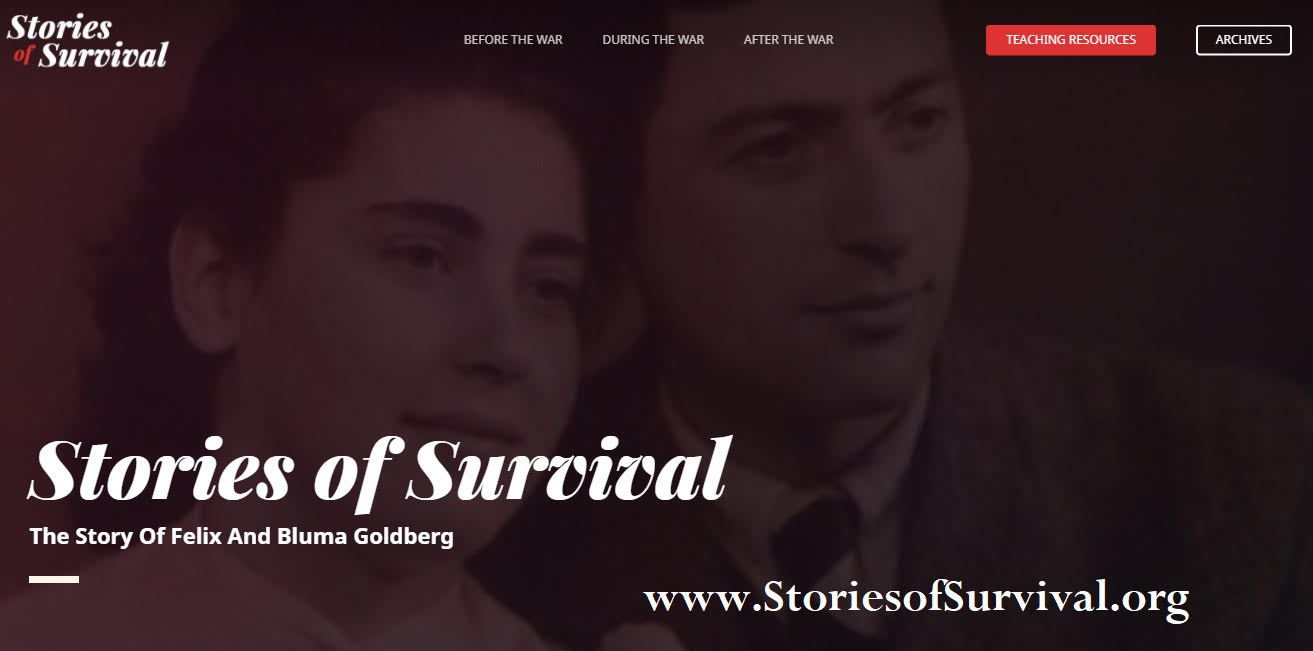An informative and important story, Frank Baker’s graphic novel illustrated by Tim Ogline, WE SURVIVED THE HOLOCAUST: THE BLUMA AND FELIX GOLDBERG STORY (Imagine and Wonder, 2022), chronicles the true story of Bluma and Felix, two young adults who survived the Holocaust. Frank is a media literacy educator and advocate, and the book’s website features a teacher guide: https://wesurvivedtheholocaust.com/. The book is also available in Spanish. I look forward to learning more about the background and process of how Frank and Tim created WE SURVIVED THE HOLOCAUST. Welcome, Frank!
How did you come to know the personal story of Bluma and Felix Goldberg?
I grew up in Columbia South Carolina knowing the Goldberg family. My father and Felix were good friends. I would frequently see their daughter Esther at Jewish events. Before he passed away in 2000, Felix (obm) spoke at our synagogue during Yom Hashoah and I listened to his harrowing story of horrific cruelty and eventual survival. I was extremely moved. As he stepped off the bimah, he handed me his speech and (knowing that I was an educator) said in this strong Polish accent: “Frankie: do something with this.”
Can you tell me a bit about your decision to tell their story in a graphic novel format?
I previously worked in Orlando Florida with the public school system and part of my job was to work with school library media specialists inside their libraries. It was there (in the 1990’s) that I learned how popular the graphic novel was. (In fact, librarians told me the graphic novel gets checked out and frequently does not get returned.) I first asked the Goldberg family for permission to tell their father and mother’s story– as a website. I took the Goldberg story and created an educational resource website for educators: www.StoriesofSurvival.org and shared it with teachers here in South Carolina. A short time later, realizing that many young people are oblivious to the scope of the Holocaust, I decided (after conferring with some experts) that the graphic novel was the perfect way to reach young adults.

How did you and Tim collaborate to create the art for the graphic novel?
After receiving a contract to write the book, I began to draft scenes and dialogue. I would communicate this to Tim. We would connect via ZOOM weekly and he would share with me his illustrations. Educating me as to his process, he shared a content map where he determined how many pages and illustrations would be needed for each scene which provided us a framework to determine how some scenes may expand based on the narrative structure to explore the human and dramatic moments. He was the consummate visual storyteller, having previously written and illustrated other graphic novels previously. At his and my editor’s recommendation, we expanded the Goldberg story to include a brief history on the rise of antisemitism during the time period depicted in the book. We believe it is vital, if not important, that students understand how Jews were subjected to propaganda, inhumane conditions, harsh laws and eventual death.
There is an image in our book‚ that Tim sent to me for review—showing Bluma Tishgarten and her family running from their home that had been set afire by the Nazis when they invaded Poland. When I first saw this image, I said to myself “this is UKRAINE”; this is exactly what is happening today—people forced from their homes; they don’t know where they will sleep tonight; they don’t know where their next meal will come from; they don’t know if they’ll see the Sun rise tomorrow morning. I think it will be important, as educators use this book, and as students read it, that they realize even though the Holocaust happened, many of the same abuses and crimes are happening today.


As years pass, young readers will be less familiar with personal stories of the Holocaust. It’s a difficult topic for kids. What age group do you think is appropriate for WE SURVIVED THE HOLOCAUST?
In the US social studies teaching standards, the Holocaust occurs between 5th and 12th grades. As an educator, that is the audience I knew would benefit mostly from the book. But I have also heard from parents and grandparents who have read it and appreciate it. I have also heard that best practice in Holocaust education involves exposing students to authentic narratives. We believe this book satisfies that requirement.

How did working on this book connect to the work you do as a media literacy educator?
It was not difficult for me to ignore media literacy here because today there is so much disinformation, Holocaust denial and distortion, many of which reside on social media–which is where most young people are today. We know, through research and anecdotal evidence, that many young people today don’t take the time to stop, reflect and verify what they consume.
So verification of facts in his book was also something that Tim and I took seriously. Tim also spent a great deal of time communicating with researchers from the United States Holocaust Memorial Museum as well as researchers from Bergen-Belsen and Dachau to verify certain facts and figures. If you’re going to write a book about the Holocaust, you want to make sure it is accurate.
We had hours of recorded oral testimony from the Goldbergs as well as access to the adult Goldberg children available to share accounts of what their parents had heard from Felix and Bluma had passed along to them over the years. We had to use journalistic methods to confirm and validate what we understood from primary and secondary resources as well as chase down leads in this story.
As an example, in a videotape testimony Felix recalled returning to a concentration camp to discover that the Americans had bombed a portion of the camp. Upon verification, Tim discovered that it was actually the Soviets that were responsible.
Another instance that crystallized during our investigation resulted from Tim’s consultation with the Dachau research team, we were able to add a whole new dimension to the story of Bluma’s time in the Dachau prison camp system… we knew that Bluma and her sister Cela had painted planes. But, what we didn’t know is that after a harrowing journey by rail from Bergen-Belsen to Dachau (which she miraculously survived) is her experience working in the Kuno Works in the Scheppach Forest. This is where slave laborers were in the process of manufacturing the ME-262, the Messerschmidt 262… the world’s first jet fighter. This was during the waning days of World War II and God knows how the tide may have turned if the Nazis were able to successfully get these planes into combat if the work had been completed.
PS Readers may be interested in other elements of this story; for example I had created a “voice clone” of Felix reading the speech he gave in 2000 (because it was not recorded). All of that is described in this recently published news story
Columbia businessman’s Holocaust survival story used to educate | Local News | postandcourier.com
Thank you, Frank.
Frank W. Baker is an internationally recognized media literacy educator. He maintains the Media Literacy Clearinghouse and Close Reading The Media websites. His lifelong work in media literacy was recognised in 2019 by UNESCO. He is the author of “Close Reading The Media” and “Media Literacy in the K-12 Classroom.” He resides in Columbia, South Carolina.


I am glad to see a Holocaust book in a graphic novel format, helping to expand the reach and awareness to a wider youth audience.
I agree, Liz. It’s so important.